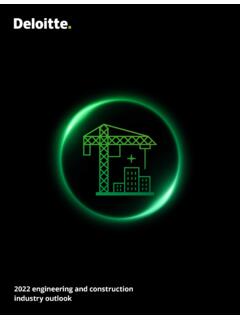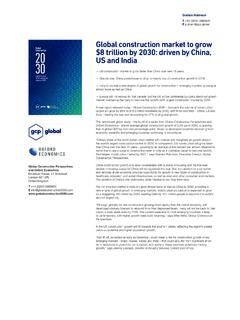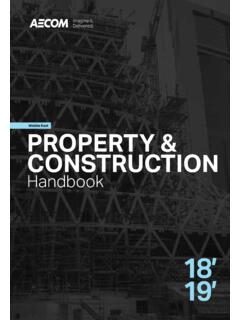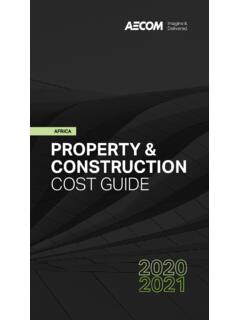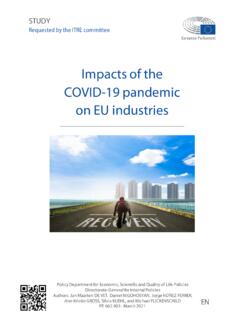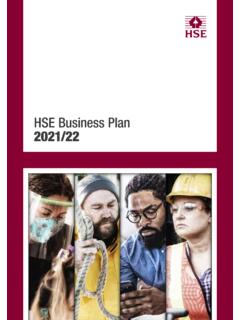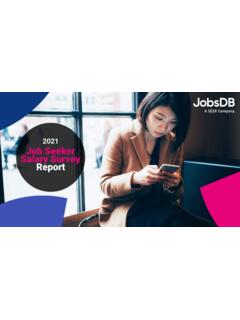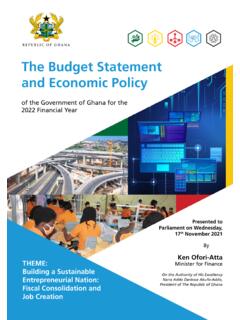Transcription of 2021 engineering and construction industry outlook - …
1 N 2021 engineering and construction industry outlook 2021 engineering and construction industry outlook E&C companies adapt to ongoing impacts of the pandemic The US engineering and construction (E&C) industry and hospitality), while others were not able to capitalize began 2020 on a bright note. The construction industry on technology advancements. Most E&C companies added more than $900 billion to the US economy in the continue to face sustained cost and margin pressures. first quarter of 2020 the highest levels since the 2008 Additionally, despite strong order books, companies It employed million people in February are experiencing challenges such as project delays 2020, also the highest levels since the 2008 and cancellations and difficulty in obtaining permits.
2 In Then, COVID-19 reached the US. The industry lost $ addition, increases in procurement cost of materials and billion in GDP, and total jobs decreased to roughly equipment continue to perplex many E&C companies. million, effectively wiping out two years of GDP gains and four years of job But there are reasons to be optimistic. Connected technologies and an increase in associated investments The E&C industry , however, had learned from the 2008 may help firms realize new operational efficiencies. recession and was well-positioned to weather this New business models and an increase in M&A activity economic shock.
3 It had better control over its leverage are further accelerating the shift toward digital and and credit and had created a buffer through additional operational efficiencies. Also, E&C companies are likely cost savings. However, industry performance during the to help other industries unlock the future of workplace rest of 2020 has been mixed. Some E&C companies were solutions. more exposed to COVID-19 affected segments (like retail About the study : Deloitte postelection survey To understand the outlook and perspectives of organizations across the energy, resources, and industrials industries, Deloitte fielded a survey of more than 350 US executives and other senior leaders in November 2020 following the 2020 US presidential election.)
4 The survey captured insights from respondents in five specific industry groups: chemicals and specialty materials, engineering and construction , industrial products, oil and gas, and power and utilities. 2021 prospects 1. An uptick in public and commercial spending could improve the outlook for 2021. In March, the pandemic made its presence felt across the E&C industry , causing the Associated Builders and Contractors' construction Confidence Index (CCI) to plummet to By June, however, the CCI rose to , indicating expansion in The industry has also seen construction spending gradually recovering from the sudden decline in the first half of A Deloitte postelection poll (see About the study ) found that 68%.
5 Of the E&C executives surveyed characterize the business outlook for their industry as somewhat or very positive. Overall business performance in 2020 can be described as uneven, depending on where an E&C firm sits in the postpandemic economy. The housing segment is recovering on the back of low mortgage rates, and US housing starts are expected to grow in On the homebuilders'. front, extra credit buffers and conservative financial policies are likely to keep confidence In contrast, the nonresidential segment new construction value is expected to register double-digit declines in Apart from health care, public safety, and water infrastructure, spending in other nonresidential segments either remained the same or declined.
6 Lodging (including hotels and motels), manufacturing facilities and structures, amusement and recreation, and office segments observed the biggest spending declines in 2020 compared with Many companies are also evaluating their future office space requirements as remote and work-from-home models evolve, leading many commercial clients to either delay or cancel their existing leases and contracts. This weakness is likely to persist well into The different outlooks for residential and nonresidential segments can present various challenges for E&C companies in 2021. Smaller E&C. firms with less balanced portfolios or a higher exposure to energy, travel, hospitality, or recreation end markets are likely to experience greater volatility in the coming year.
7 Larger E&C firms with more diversified exposure may absorb this impact better. While the residential segment is expected to recover through 2021, overall spending growth in 2021 will likely be led by an uptick in public, infrastructure, and commercial building starts and related investments. In fact, in a Deloitte postelection poll, 70% of E&C. leaders agree that new infrastructure projects, if fully approved, can help jump-start the economy. 2021 engineering and construction industry outlook 3. Margin disruption 2. Connected construction and modularization can address long-term costs and margin issues The E&C industry has been operating on razor-thin margins for many years now, and the situation has only worsened since the pandemic In our 2020 outlook , we mentioned how the Turner Building Cost Index, which measures US nonresidential building construction market cumulative costs (including labor rates and productivity, materials prices, and competitive marketplace conditions)
8 Had reached a value of 1162, the highest levels in its 13-year The pandemic led the index to reach a new peak of 1189 by the end of the first quarter of Since then, the index remains near the all-time high, likely driven by rising labor and material costs and supply disruption as global supply chains continue to A similar impact can be seen on margins as well. The September Associated Builders and Contractors survey shows that almost 77% of contractors surveyed indicate no change or a decline in profit margins, up about 10% from a month Despite many E&C firms altering their cost structures, most suffered due to increasing material costs, contract extensions, and even extended schedules leading to cost overruns.
9 To reverse this situation, E&C companies should consider several ways to create long-term efficiencies and competitive advantage in 2021. One option is to save costs via modularization and prefabrication design. Twenty-six percent of E&C executives in a Deloitte postelection poll indicate increasing Another approach is to change the focus of technology their use of prefabrication and modular products. Module assembly yards investments from isolated projects to integrated, borrow some of the cost-efficiencies of manufacturing and could lead to enterprise-level initiatives. Firms should make considerable cost savings, ranging from 6% to 30%.
10 17 Besides material costs, technology investments that solve business-level modularization and prefabrication can also help reduce labor costs, ensure efficiency problems instead of stand-alone better design and quality control, and shorten the project schedule to project-related issues. Through enterprise-scale ensure minimum budget overruns. technology investments, E&C companies can develop a connected construction foundation a dynamic, And, although this is a longer-term potential payoff, E&C firms can also always-on network that provides continuous access invest and move toward advanced construction materials, such as durable to information, analytics, and Benefits are or high-strength concrete, geosynthetics, geotextiles, fire-resistant timbers, expected to include as much as a potential 10% to 30%.










